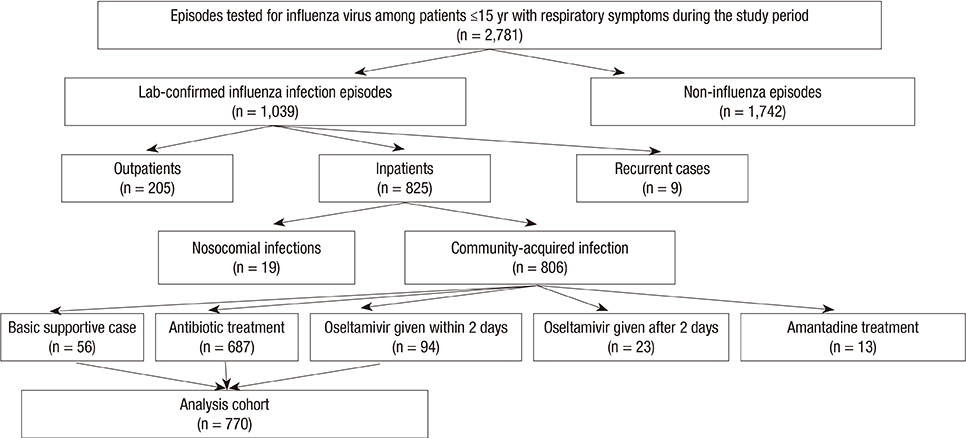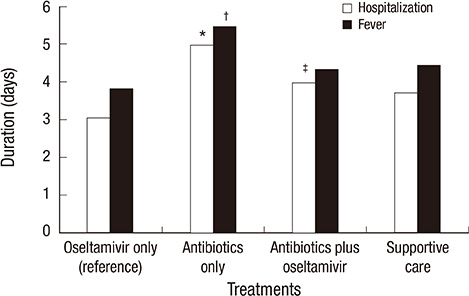J Korean Med Sci.
2014 Apr;29(4):485-493. 10.3346/jkms.2014.29.4.485.
The Association between Influenza Treatment and Hospitalization-Associated Outcomes among Korean Children with Laboratory-Confirmed Influenza
- Affiliations
-
- 1International Vaccine Institute, Seoul, Korea.
- 2Department of Pediatric Pulmonology & Allergy, Asan Medical Center, Seoul, Korea.
- 3Department of Pharmacy Practice, Eugene Applebaum College of Pharmacy and Health Sciences, Wayne State University, Detroit, MI, USA.
- 4Department of Epidemiology, Gillings School of Global Public Health, University of North Carolina at Chapel Hill, NC, USA.
- 5Department of Pediatrics, College of Medicine, Korea University, Seoul, Korea. byelhana@korea.ac.kr
- 6Department of Pediatrics, Inje College of Medicine, Seoul, Korea.
- KMID: 1774452
- DOI: http://doi.org/10.3346/jkms.2014.29.4.485
Abstract
- There are limited data evaluating the relationship between influenza treatment and hospitalization duration. Our purpose assessed the association between different treatments and hospital stay among Korean pediatric influenza patients. Total 770 children < or = 15 yr-of-age hospitalized with community-acquired laboratory-confirmed influenza at three large urban tertiary care hospitals were identified through a retrospective medical chart review. Demographic, clinical, and cost data were extracted and a multivariable linear regression model was used to assess the associations between influenza treatment types and hospital stay. Overall, there were 81% of the patients hospitalized with laboratory-confirmed influenza who received antibiotic monotherapy whereas only 4% of the patients received oseltamivir monotherapy. The mean treatment-related charges for hospitalizations treated with antibiotics, alone or with oseltamivir, were significantly higher than those treated with oseltamivir-only (P < 0.001). Influenza patients treated with antibiotics-only and antibiotics/oseltamivir combination therapy showed 44.9% and 28.2%, respectively, longer duration of hospitalization compared to those treated with oseltamivir-only. Patients treated with antibiotics, alone or combined with oseltamivir, were associated with longer hospitalization and significantly higher medical charges, compared to patients treated with oseltamivir alone. In Korea, there is a need for more judicious use of antibiotics, appropriate use of influenza rapid testing.
Keyword
MeSH Terms
-
Adolescent
Anti-Bacterial Agents/*therapeutic use
Antigens, Viral/analysis/immunology
Antiviral Agents/*therapeutic use
Child
Child, Preschool
Cohort Studies
Demography
Drug Therapy, Combination
Female
Hospitalization
Humans
Infant
Infant, Newborn
Influenza A virus/metabolism
Influenza B virus/metabolism
Influenza, Human/*drug therapy
Male
Oseltamivir/*therapeutic use
Republic of Korea
Retrospective Studies
Anti-Bacterial Agents
Antigens, Viral
Antiviral Agents
Oseltamivir
Figure
Reference
-
1. Molinari NA, Ortega-Sanchez IR, Messonnier ML, Thompson WW, Wortley PM, Weintraub E, Bridges CB. The annual impact of seasonal influenza in the US: measuring disease burden and costs. Vaccine. 2007; 25:5086–5096.2. Newall AT, Scuffham PA. Influenza-related disease: the cost to the Australian healthcare system. Vaccine. 2008; 26:6818–6823.3. Neuzil KM, Wright PF, Mitchel EF Jr, Griffin MR. The burden of influenza illness in children with asthma and other chronic medical conditions. J Pediatr. 2000; 137:856–864.4. Neuzil KM, Zhu Y, Griffin MR, Edwards KM, Thompson JM, Tollefson SJ, Wright PF. Burden of interpandemic influenza in children younger than 5 years: a 25-year prospective study. J Infect Dis. 2002; 185:147–152.5. Bhat N, Wright JG, Broder KR, Murray EL, Greenberg ME, Glover MJ, Likos AM, Posey DL, Klimov A, Lindstrom SE, et al. Influenza-associated deaths among children in the United States, 2003-2004. N Engl J Med. 2005; 353:2559–2567.6. Ampofo K, Gesteland PH, Bender J, Mills M, Daly J, Samore M, Byington C, Pavia AT, Srivastava R. Epidemiology, complications, and cost of hospitalization in children with laboratory-confirmed influenza infection. Pediatrics. 2006; 118:2409–2417.7. Keren R, Zaoutis TE, Saddlemire S, Luan XQ, Coffin SE. Direct medical cost of influenza-related hospitalizations in children. Pediatrics. 2006; 118:e1321–e1327.8. Neuzil KM, Hohlbein C, Zhu Y. Illness among schoolchildren during influenza season: effect on school absenteeism, parental absenteeism from work, and secondary illness in families. Arch Pediatr Adolesc Med. 2002; 156:986–991.9. Heikkinen T, Silvennoinen H, Peltola V, Ziegler T, Vainionpaa R, Vuorinen T, Kainulainen L, Puhakka T, Jartti T, Toikka P, et al. Burden of influenza in children in the community. J Infect Dis. 2004; 190:1369–1373.10. Kaiser L, Wat C, Mills T, Mahoney P, Ward P, Hayden F. Impact of oseltamivir treatment on influenza-related lower respiratory tract complications and hospitalizations. Arch Intern Med. 2003; 163:1667–1672.11. Nicholson KG, Aoki FY, Osterhaus AD, Trottier S, Carewicz O, Mercier CH, Rode A, Kinnersley N, Ward P. Efficacy and safety of oseltamivir in treatment of acute influenza: a randomised controlled trial: Neuraminidase Inhibitor Flu Treatment Investigator Group. Lancet. 2000; 355:1845–1850.12. Sato M, Saito R, Sato I, Tanabe N, Shobugawa Y, Sasaki A, Li D, Suzuki Y, Sato M, Sakai T, et al. Effectiveness of oseltamivir treatment among children with influenza A or B virus infections during four successive winters in Niigata City, Japan. Tohoku J Exp Med. 2008; 214:113–120.13. Neuzil KM, Mellen BG, Wright PF, Mitchel EF Jr, Griffin MR. The effect of influenza on hospitalizations, outpatient visits, and courses of antibiotics in children. N Engl J Med. 2000; 342:225–231.14. Carrat F, Schwarzinger M, Housset B, Valleron AJ. Antibiotic treatment for influenza does not affect resolution of illness, secondary visits or lost workdays. Eur J Epidemiol. 2004; 19:703–705.15. Chidiac C, Maulin L. Using antibiotics in case of influenza. Med Mal Infect. 2006; 36:181–189.16. Cao B, Li R, Liu YM, Cao ZX, Geng XQ, Lau LT, Lu J, Wu L, Cui SF, Bai RT, et al. The impact of antibiotic treatment in patients with influenza-like illness. Zhonghua Jie He He Hu Xi Za Zhi. 2008; 31:483–487.17. Kee SY, Lee JS, Cheong HJ, Chun BC, Song JY, Choi WS, Jo YM, Seo YB, Kim WJ. Influenza vaccine coverage rates and perceptions on vaccination in South Korea. J Infect. 2007; 55:273–281.18. Poehling KA, Edwards KM, Weinberg GA, Szilagyi P, Staat MA, Iwane MK, Bridges CB, Grijalva CG, Zhu Y, Bernstein DI, et al. The underrecognized burden of influenza in young children. N Engl J Med. 2006; 355:31–40.19. Moran K, Maaten S, Guttmann A, Northrup D, Kwong JC. Influenza vaccination rates in Ontario children: implications for universal childhood vaccination policy. Vaccine. 2009; 27:2350–2355.20. Kim YK, Nyambat B, Hong YS, Lee CG, Lee JW, Kilgore PE. Burden of viral respiratory disease hospitalizations among children in a community of Seoul, Republic of Korea, 1995 - 2005. Scand J Infect Dis. 2008; 40:946–953.21. Pee SY, Choi Y, Lee BC, Lee HJ, An HS, Hwang TJ, Lee SY, Seo JG, Oh SH, Hwang YS. Hongchangeui textbook of pediatrics. 8th ed. Seoul: Korean Textbook Press;2004.22. Gums JG, Pelletier EM, Blumentals WA. Oseltamivir and influenza-related complications, hospitalization and healthcare expenditure in healthy adults and children. Expert Opin Pharmacother. 2008; 9:151–161.23. Ciesla G, Leader S, Stoddard J. Antibiotic prescribing rates in the US ambulatory care setting for patients diagnosed with influenza, 1997-2001. Respir Med. 2004; 98:1093–1101.24. Reisinger K, Greene G, Aultman R, Sander B, Gyldmark M. Effect of influenza treatment with oseltamivir on health outcome and costs in otherwise healthy children. Clin Drug Investig. 2004; 24:395–407.25. Hassan F, Lewis TC, Davis MM, Gebremariam A, Dombkowski K. Hospital utilization and costs among children with influenza, 2003. Am J Prev Med. 2009; 36:292–296.26. Jeong HS. Health care reform and change in public-private mix of financing: a Korean case. Health Policy. 2005; 74:133–145.27. Ploin D, Gillet Y, Morfin F, Fouilhoux A, Billaud G, Liberas S, Denis A, Thouvenot D, Fritzell B, Lina B, et al. Influenza burden in febrile infants and young children in a pediatric emergency department. Pediatr Infect Dis J. 2007; 26:142–147.28. Low D. Reducing antibiotic use in influenza: challenges and rewards. Clin Microbiol Infect. 2008; 14:298–306.29. Noyola DE, Demmler GJ. Effect of rapid diagnosis on management of influenza A infections. Pediatr Infect Dis J. 2000; 19:303–307.30. De La Rocque F, Lécuyer A, Wollner C, d'Athis P, Pecking M, Thollot F, Cohen R. Impact of influenza rapid diagnostic tests (IRDT) on the diagnosis of influenza and on the management of influenza in children in ambulatory pediatric setting. Arch Pediatr. 2009; 16:288–293.31. Peltola V, Ziegler T, Ruuskanen O. Influenza A and B virus infections in children. Clin Infect Dis. 2003; 36:299–305.32. Bonner AB, Monroe KW, Talley LI, Klasner AE, Kimberlin DW. Impact of the rapid diagnosis of influenza on physician decision-making and patient management in the pediatric emergency department: results of a randomized, prospective, controlled trial. Pediatrics. 2003; 112:363–367.33. Eriksson M, Bennet R, Nilsson A. Wheezing following lower respiratory tract infections with respiratory syncytial virus and influenza A in infancy. Pediatr Allergy Immunol. 2000; 11:193–197.34. Heymann PW, Carper HT, Murphy DD, Platts-Mills TA, Patrie J, McLaughlin AP, Erwin EA, Shaker MS, Hellems M, Peerzada J, et al. Viral infections in relation to age, atopy, and season of admission among children hospitalized for wheezing. J Allergy Clin Immunol. 2004; 114:239–247.35. Lahti E, Peltola V, Virkki R, Ruuskanen O. Influenza pneumonia. Pediatr Infect Dis J. 2006; 25:160–164.36. Coffin SE, Zaoutis TE, Rosenquist AB, Heydon K, Herrera G, Bridges CB, Watson B, Localio R, Hodinka RL, Keren R. Incidence, complications, and risk factors for prolonged stay in children hospitalized with community-acquired influenza. Pediatrics. 2007; 119:740–748.37. Daley AJ, Nallusamy R, Isaacs D. Comparison of influenza A and influenza B virus infection in hospitalized children. J Paediatr Child Health. 2000; 36:332–335.38. Ruiz Laiglesia F, Zubizarreta García J, Agud Aparicio J, Villasante Claudios F, Ayensa Dean C, Sánchez Nanclares M, Torrubia Pérez C. Febrile syndrome in hospitalized patients. An Med Interna. 1992; 9:367–371.39. Dawood FS, Fiore A, Kamimoto L, Nowell M, Reingold A, Gershman K, Meek J, Hadler J, Arnold KE, Ryan P, et al. Influenza-associated pneumonia in children hospitalized with laboratory-confirmed influenza, 2003-2008. Pediatr Infect Dis J. 2010; 29:585–590.40. Falagas ME, Vouloumanou EK, Baskouta E, Rafailidis PI, Polyzos K, Rello J. Treatment options for 2009 H1N1 influenza: evaluation of the published evidence. Int J Antimicrob Agents. 2010; 35:421–430.41. Fiore AE, Fry A, Shay D, Gubareva L, Bresee JS, Uyeki TM. Centers for Disease Control and Prevention (CDC). Antiviral agents for the treatment and chemoprophylaxis of influenza: recommendations of the Advisory Committee on Immunization Practices (ACIP). MMWR Recomm Rep. 2011; 60:1–24.42. Jennings LC, Skopnik H, Burckhardt I, Hribar I, Del Piero L, Deichmann KA. Effect of rapid influenza testing on the clinical management of paediatric influenza. Influenza Other Respir Viruses. 2009; 3:91–98.
- Full Text Links
- Actions
-
Cited
- CITED
-
- Close
- Share
- Similar articles
-
- Prevention and Treatment of Influenza
- The National Influenza Surveillance System of Korea
- Influenza Vaccine
- The Clinical Characteristics of Influenza B Infection during the 2011-2012 Influenza Season
- Influenza disease burden and the need for highly immunogenic vaccines in older adults: a narrative review



